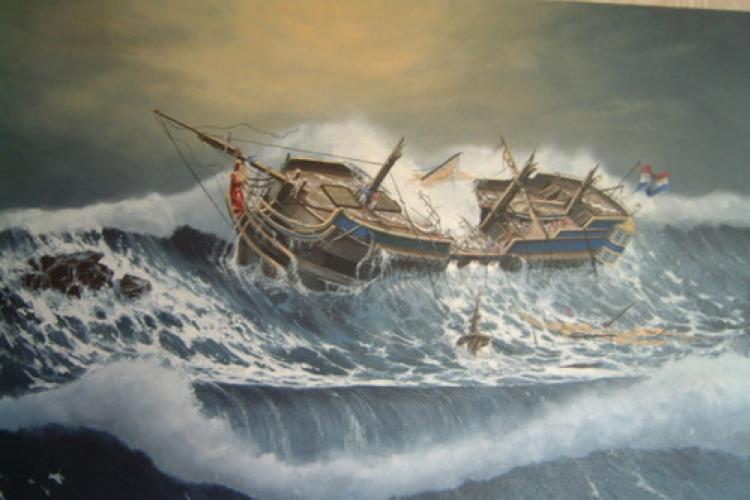Ship Construction and Cargo
The Hollandia was a 150 ft. long, 700-ton ton “retour ship”, a heavily armed, well-manned merchant ship of the Verenigde Oostindische Compagnie (“VOC” also known as the Dutch East India Company). The ship was specifically designed for the long roundtrip voyage from the Netherlands to the East Indies. The exact armament of the Hollandia is not known, but it is certain there were are least 40 guns or cannons. Her most important cargo was silver plate, amounting to 129,700 guilders in silver, Spanish Colonial and Dutch coins, as documented in the VOC account books.
Departure and Sinking
On 3 July 1743, the Hollandia set off on her maiden voyage from Texel in the Netherlands. She sank on 13 July 1743. It is known from correspondence that she was blown off course and ended up northwest of the Isles of Scilly near England. A statement in the “Survey of the Ancient and Present State of the Scilly Isles” (Sherbourne 1794) says she struck upon Gunner Rock and sank in about 22 fathoms (approximately 130 feet) depth of water. Guns were fired as a distress signal and many bodies were later found floating or on the shores of St. Mary’s and other islands. There were no survivors.
18th Century Recovery Attempt
The silver plate onboard was the property of the VOC and was to be used for trade in the Far East. For this reason, within two months of her sinking, the Amsterdam Chamber of the VOC sent a diver to locate and attempt to salvage the silver treasure. Unfortunately, 18th century diving equipment was only good to about 12 fathoms, and although the diver may have located the wreck, salvage would have been impossible.
1971 Discovery
In 1967, Rex Cowan began his search for the Hollandia. Years of research and planning resulted in two years of diving and searching the area around Gunner Rock. A proton magnetometer (which measures the intensity of the earth’s magnetic field and variations caused by ferrous materials) was used in the search. Iron cannon and anchors were detected by the magnetometer, allowing Rex Cowan’s team to visually locate the wreck in September 1971. Thousands of coins have been recovered, along with a large quantity of artifacts and various brass armaments.
Coins of Hollandia
The majority of silver coin recovered from the Hollandia consist of Spanish eight reales (also known as “pieces of eight”) minted in the Americas (Mexico mint). They were produced on the screw press and are also known as “Pillar Dollars”. The silver content of these coins was very high, which made them very desirable to the Far East traders. The purity of these silver coins was confirmed when they were compared with other New World coins and Dutch coinage found in the same underwater environment.
Another type of coin recovered from the Hollandia is the ducaton. The silver for these coins was often mined in Eastern European countries and then minted in various provinces of the Spanish Netherlands and United Provinces. The larger coins of the Netherlands were popular with merchants involved in the East Indies trade.
- Log in to post comments

